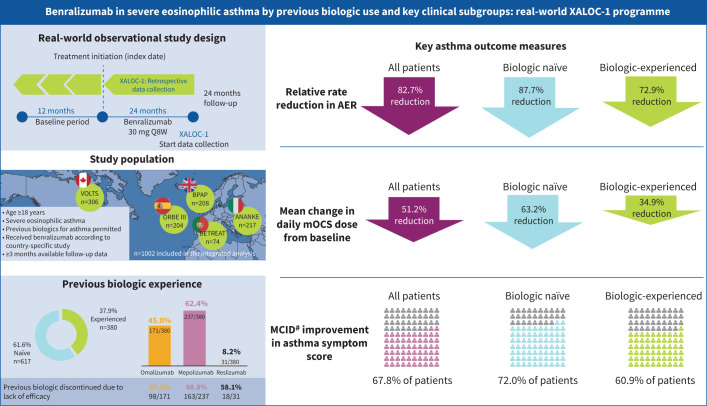- Record: found
- Abstract: found
- Article: found
Benralizumab in severe eosinophilic asthma by previous biologic use and key clinical subgroups: real-world XALOC-1 programme

Read this article at
Graphical abstract

In this large, real-world programme, patients with severe eosinophilic asthma treated with benralizumab had substantial improvements in clinical outcomes, irrespective of previous biologic use and key clinical characteristics important to decision-making in clinical practice. #: 3 units Asthma Control Test score or −0.5 units in 6-item Asthma Control Questionnaire score. AER: annualised exacerbation rate; MCID: minimal clinically important difference; mOCS: maintenance oral corticosteroid; Q8W: every 8 weeks.
Abstract
Background
Pivotal phase 3 trials and real-world studies have demonstrated benralizumab's overall efficacy and safety in severe eosinophilic asthma (SEA). Additional large-cohort data are needed to confirm its real-world effectiveness in SEA according to previous biologic use and key baseline characteristics important for treatment selection.
Methods
XALOC-1 is a large, multinational, retrospective, observational, real-world study programme of benralizumab in adults with SEA. This 48-week integrated analysis assessed annualised exacerbation rate (AER), maintenance oral corticosteroid (mOCS) use, asthma symptom control and lung function during a 12-month baseline period and up to 48 weeks after benralizumab initiation. Subgroup analyses were based on previous biologic use and key baseline clinical characteristics (mOCS use, blood eosinophil count, exacerbation history, age at asthma diagnosis, fractional exhaled nitric oxide level and presence of atopy and chronic rhinosinusitis with nasal polyps).
Results
Out of 1002 patients analysed, 380 were biologic-experienced. At week 48, 71.3% were exacerbation-free ( versus 17.2% at baseline); relative reduction in AER was 82.7% overall and 72.9% in biologic-experienced patients; rates were maintained across all key clinical characteristic subgroups. Of patients using mOCS at baseline (n=274), 47.4% (130 out of 274) eliminated their use by week 48; the mean reduction from baseline in daily dose was 51.2% and, notably, 34.9% in biologic-experienced patients (n=115). Clinically significant improvements in asthma symptom control and lung function were observed.
Shareable abstract
Patients with severe eosinophilic asthma who received benralizumab in the real world had substantially improved clinical outcomes, irrespective of prior biologic use and key clinical characteristics, including atopic status and F ENO levels https://bit.ly/3TTGveS
Related collections
Most cited references42
- Record: found
- Abstract: found
- Article: not found
Efficacy and safety of benralizumab for patients with severe asthma uncontrolled with high-dosage inhaled corticosteroids and long-acting β2-agonists (SIROCCO): a randomised, multicentre, placebo-controlled phase 3 trial
- Record: found
- Abstract: found
- Article: not found